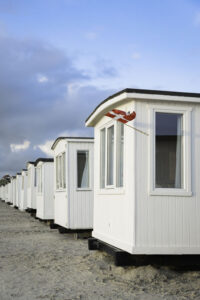
Purchasing a used park model home can seem like a smart, cost-effective option—until you realize it needs to be moved. That’s when things get more complicated. The structure itself might be affordable, but transporting it safely requires more than just a willingness to buy. At Outback Transport LLC, we’ve worked with plenty of folks who’ve taken ownership of a park model, only to discover that relocation isn’t as straightforward as they expected. If you’re planning to buy a park model that needs to be moved, asking the right questions early on can save you time, money, and a lot of unnecessary frustration.
First, Make Sure the Unit Is Move-Ready
Just Because It Has Wheels Doesn’t Mean It Can Roll
Park models are built to be moveable—but often only once or twice in their lifetime. Over time, they tend to settle into place. Some have had decks added, skirting installed, or structural changes made that make moving them difficult or risky.
When considering a unit for purchase, get a clear picture of its current setup. Has it been stationary for years? Is it still sitting on its original axles and tires? Are those tires still usable? Has the frame been exposed to moisture or corrosion?
It’s also worth checking for:
- Sagging or cracked rooflines
- Damage near load-bearing corners
- Water damage around the skirting or floor
We’ve seen many “mobile” park models that turned out to be far from move-ready. Getting these answers upfront can make the difference between a smooth relocation and a structure that isn’t worth the trouble.
Know What You’re Actually Buying
Not all compact homes are true park models. If you’re purchasing from a private seller, make sure you’re not getting a cabin-style shed or custom-built structure misrepresented as a park model. What you want is an ANSI-certified park model home, typically with a data plate and serial number that verifies how it was built.
A proper park model will usually have:
- A VIN or HUD tag
- Original documentation from the manufacturer
- A title or bill of sale that proves ownership
Without this documentation, you may hit a wall when it comes time to get transport permits or prove ownership to a county or utility provider.
Ask the Seller the Right Questions Before You Commit
What’s the Story Behind the Structure?
Don’t just walk through the interior and fall in love with the finishes. Ask the seller why the park model is for sale and where it’s been located. Has it been moved before? If so, was there any damage during previous transport? Did a professional mover handle it?
A one-time delivery from the factory is common, but if the structure has seen multiple moves or DIY attempts, it may have sustained damage that’s not obvious right away.
Also ask:
- Has the unit ever had structural repairs?
- Are there any leaks, past or present?
- Was it used as a permanent residence or a seasonal home?
These details help paint a clearer picture of what you’re really working with.
Can It Be Removed from the Current Lot?
Another overlooked issue is whether the park model can be removed from its current location at all. In RV parks, retirement communities, or mobile home parks, there may be restrictions in place.
Some sites have:
- Specific removal timelines
- Narrow lot access
- Overhead trees or powerlines
- Rules that require written notice or approval before moving a structure
If you’re buying a unit located in a park or private community, it’s essential to speak with management. We’ve had moves delayed—or even canceled—because removal wasn’t permitted during certain seasons or because of unresolved lot rental agreements.
Plan the Move Before the Purchase Is Final
Schedule a Site Review with a Professional
If you’re not 100% sure the unit is movable, this is the time to bring in a park model mover. At Outback Transport, we frequently evaluate locations before a purchase closes. We check access roads, turning clearance, soft ground, obstacles like fences or trees, and overall structure condition to determine whether the move is possible—and what it will realistically cost.
In many cases, a pre-purchase evaluation helps buyers avoid big mistakes. If a park model must be partially disassembled or lifted over a fence just to remove it, you want to know that before you buy.
We’ve seen it all—tight mountain lots in Grangeville, narrow city alleys in Spokane, even cabins placed in spots that require 4×4 equipment just to reach. The sooner we can assess the site, the better.
Moving Costs Extend Beyond the Drive
When planning your budget, remember that transport is only part of the equation. You’ll also want to account for:
- Hiring licensed pros to disconnect water, sewer, power, and propane
- Removing any attached skirting, decks, or porches
- Securing permits and scheduling pilot cars if needed
- New site prep and utility reconnection after delivery
These costs can vary widely depending on where the park model is going and how accessible the new location is. The total cost of ownership often goes well beyond the listing price.
Protect Your Investment by Doing Your Homework
A used park model can be a fantastic option—affordable, functional, and flexible. But when relocation is involved, there’s more to the process than most buyers expect. Taking the time to ask these questions upfront can help you avoid expensive surprises and ensure you’re making a smart decision.
If you’re in the process of buying a used park model and plan to relocate it anywhere in North Idaho, Eastern Washington, or even into Oregon, give us a call. Outback Transport is here to help you move forward with confidence—literally. We’ll assess the situation, help you understand the logistics, and ensure the transition from “for sale” to “welcome home” goes off without a hitch. Give us a call today at 208.490.1482 to get started on your moving project!

Leave a Reply